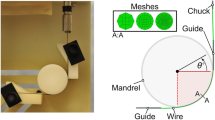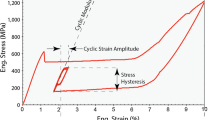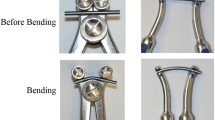Abstract
Harrington rods failed after a short period in service. Metallurgical analysis showed (1) notches were present on the rods, (2) small cracks present in the bent regions of the rod, and (3) the fractures occurred at clamped locations. All of these conditions can shorten the fatigue life by eliminating the crack initiation stage of fatigue and allowing corrosion fatigue to occur.

















Similar content being viewed by others
References
http://www.scoliosis.org/resources/medicalupdates/instrumentationsystems.php. Accessed 20 June 2013
L.A. Shepard et al., Characterization of a failed spinal implant (Harrington rod), in ASM Conference Proceedings, Metals Park (1988), pp. 411–418
ASTM F136-02a, Standard specification for wrought titanium–6 aluminum–4 vanadium ELI (extra low interstitial) alloy for surgical implant applications (UNS R56401), 2002
R. Boyer, E.W. Collings, G. Welsch (eds.), Materials Properties Handbook: Titanium Alloys (ASM International, Materials Park, 1994), pp. 483–636
H.J. Snyder et al., Fatigue fracture of 316L SS screws employed for surgical implanting, in Handbook of Case Histories in Failure Analysis, vol. 1, ed. by K.A. Esakul (ASM International, Materials Park, 1992)
M. Prikryl et al., Role of corrosion in Harrington and Luque rods failure. Biomaterials 10, 109–117 (1989)
M. Hahn et al., The influence of material and design features on the mechanical properties of transpedicular spinal fixation implants. J. Biomed. Mater. Res. 63, 354–362 (2002)
H. Stürz et al., Damage analysis of the Harrington Rod fracture after scoliosis operation. Arch. Orthop. Trauma Surg. 95, 113–122 (1979)
J.S. Kirkpatrick et al., Corrosion on spinal implants. J. Spinal Disord. Tech. 18, 247–251 (2005)
A.C. Fraker, Forms of corrosion in implant materials, in Metals Handbook, vol 13, 9th edn. (ASM International, Materials Park, 1987), pp. 1324–1335
L. Aulisa et al., Corrosion of the Harrington’s instrumentation and biological behavior of the rod–human spine system. Biomaterials 3, 246–249 (1982)
J.B. Brunski et al., Stresses in a Harrington distraction rod: their origin and relationship to fatigue fractures in vivo. J. Biomech. Eng. 105, 101–107 (1983)
C. Sittig et al., Surface characterization of implant materials c.p. Ti, Ti–6Al–4V and Ti–6Al–4V with different pretreatments. J. Mater. Sci. Mater. Med. 10(1), 35–46 (1999)
S. Hur, The 360° cold bending of Ti–6Al–4V large diameter seamless tube. JOM 51(6), 28–30 (1999)
R.W. Hertzberg, Deformation and Fracture Mechanics of Engineering Materials (Wiley, New York, 1976)
Author information
Authors and Affiliations
Corresponding author
Rights and permissions
About this article
Cite this article
Reitz, W. Cervical Stent Failure Analysis. J Fail. Anal. and Preven. 13, 678–683 (2013). https://doi.org/10.1007/s11668-013-9749-3
Received:
Revised:
Published:
Issue Date:
DOI: https://doi.org/10.1007/s11668-013-9749-3




